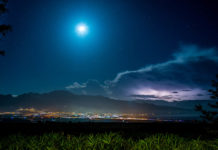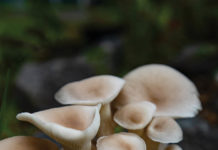By Shannon Wianecki

November coincides with the onset of ho‘oilo: rainy season in Hawai‘i. But in the Islands, wet weather doesn’t signify a monotonous sog-fest. Thanks to persistent trade winds and vacillating temperatures across mountainous terrain, the Hawaiian Archipelago possesses some of Earth’s most diverse rainfall patterns. Our precipitation ranges from lacy, tiptoeing mists to roof-rattling downpours. It often changes personality from one street to the next. On Haleakala’s leeward shore, the parched community of Kihei receives less than 11 inches of rain a year — much of which seems to arrive in a single, shocking cloudburst. Not far afield, the Kukui rain gauge in the West Maui Mountains registers almost 366 inches a year. This supersaturated environment is wreathed year-round in fog.
These extreme ends of the rainbow — along with every shade in between — were well known to ancient Hawaiians, who composed some 2,000 names for rain. The most general term, ua, is a tiny verbal ledge from which a cascade of descriptors flows. Ua hanai evokes a gentle shower that nourishes the landscape as a parent nurtures a child; nakikiki‘i is the wind-driven slanting rain; and kahakiki refers to a bruising downpour. Perhaps you can recall a time you felt pakaku, large, splattering droplets, or ililani, an unexpected drenching from a seemingly clear sky.
Many of the Hawaiian names for rain are site specific. Uakea, for example, describes the white mist of Hana. And anyone who has traveled through East Maui has likely experienced ka ua pe‘e pu hala o Huelo (the Huelo rain that makes one hide in a hala grove). Pi‘iholo’s famous precipitation, the yellowish-red rain known as ‘ulalena, inspired the long-running theatrical performance of the same name. Midway through the show, audience members are instructed to rub their hands together to simulate the soft sound of water falling through the forest.
A few years back, a British journalist complained that perhaps the Hawaiians got carried away. He asked, “Do we really need anything so specific as ua pa‘u pili [the rain that moistens the pili grass at Lahaina]?” Scientists argue that we absolutely do. Hydrological experts with the University of Hawai‘i recently completed the Rainfall Atlas of Hawai‘i, a comprehensive record of rainfall throughout the state. Resource managers can now use this tool when developing and protecting ground and surface water, restoring forests, and responding to the effects of global warming. You can use the interactive maps at www.rainfall.geography.hawaii.edu to find the weather that suits your mood the best.


















